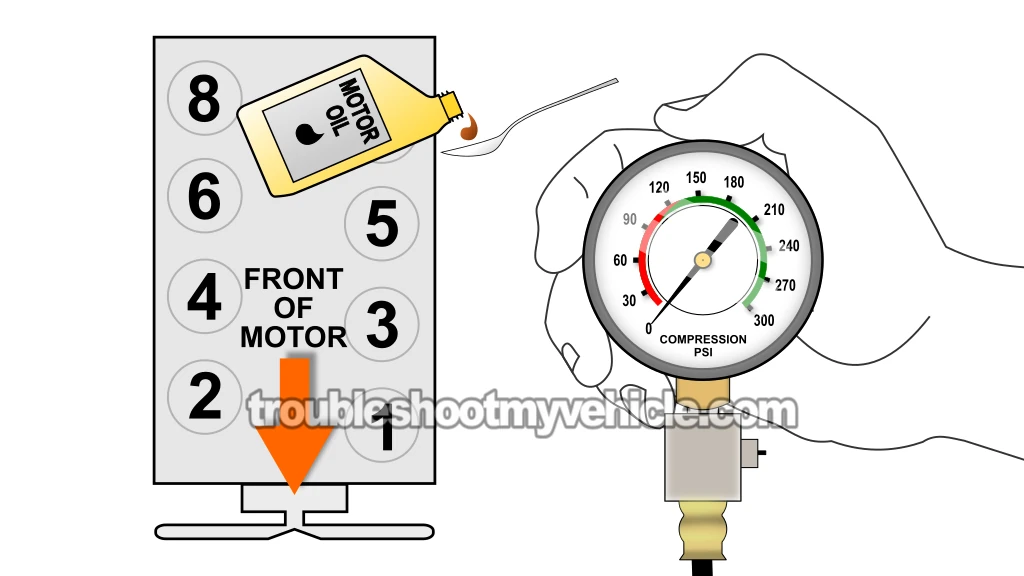Interpreting The Engine Compression Test Results
It's quite possible that your compression test shows one or more cylinders with noticeably lower readings than the others.
To a certain extent, this can be perfectly normal and may not cause any real drivability issues.
However, once a cylinder's compression drops more than 15% below the highest reading the engine produces, you're gonna experience performance problems.
Why does this matter? Because if a cylinder's compression is more than 15% lower, it's going to misfire —and at that point, it's essentially a "dead" cylinder.
You've got two options here: You can either figure out the 15% margin with a simple manual calculation, or you can use my handy online tool. Here's the link to it: Online Low Engine Compression Calculator (hosted at easyautodiagnostics.com).
If you'd prefer to work it out by hand, here's how to calculate it step by step:
- STEP 1: Multiply the highest compression reading by 0.15 (which represents 15%).
- STEP 2: Round that result to the nearest whole number (for instance, 25.6 becomes 26).
- STEP 3: Subtract that rounded number from your highest compression value.
- ANSWER: The number you get is the lowest compression reading any cylinder can have before it starts causing problems.
Let me walk you through an example using actual numbers: Say I measured the following compression values:
| Cylinder | Pressure |
|---|---|
| #1 | 165 PSI |
| #2 | 95 PSI |
| #3 | 155 PSI |
| #4 | 175 PSI |
| #5 | 160 PSI |
| #6 | 165 PSI |
| #7 | 160 PSI |
| #8 | 160 PSI |
My next step is to do the following calculation:
- STEP 1: 175 x 0.15 = 26.25.
- STEP 2: 26.25 = 26 (rounded to nearest one).
- STEP 3: 175 - 26 = 149.
- ANSWER: 149 PSI. Any cylinder with this compression (or lower) value will misfire.
Because cylinder #2 is only showing 95 PSI, I can safely say it's a "dead" cylinder and the cause of the misfire.
To determine whether the lowest reading from your compression test falls within an acceptable range, you'll need to run the same calculation. Just be sure to use the highest compression value from your engine —not the number from this example.
Once you've identified the cylinder with low compression, the next step is figuring out what's behind the drop in pressure. To do that, head over to: TEST 2: Wet Engine Compression Test.
TEST 2: Wet Compression Test

Once you've identified the "dead" cylinder (the one with very low or zero compression) the next thing to determine is why that cylinder has lost compression.
The goal here is to find out whether the issue lies with worn piston rings or with faulty cylinder head valves. To do that, you'll need to perform a "wet" compression test.
Now you might be wondering, "What exactly is a wet compression test"? It's basically a slight variation of the dry compression test you already did.
The key difference is that you'll pour about two tablespoons of engine oil into the cylinder that showed low compression during the dry test.
If worn piston rings are to blame, the oil will temporarily help seal them, and you'll notice a noticeable jump in the compression reading —bringing it closer to the others.
On the other hand, if the issue is with the cylinder head valves, the oil won't make any difference, and the compression value will remain low.
Here's how to perform the wet compression test:
- 1
Add one to two tablespoons of motor oil to the cylinder you're retesting.
Use a funnel to make sure the oil goes directly into the cylinder without spilling. - 2
Thread the compression gauge into that same cylinder and hand-tighten it —no tools needed.
- 3
Have a helper crank the engine until the needle on the gauge stops rising.
- 4
Now observe the result —you'll see one of two outcomes:
1.) The gauge needle rises noticeably higher than before, indicating improved compression.
2.) The gauge needle shows little to no change from the original dry test.
Whatever the result, make sure to write it down again. - 5
If there are other cylinders that need retesting, go ahead and repeat steps 1 through 4 on them as well.
Now let's go over what your results actually mean:
CASE 1: The compression reading went up. This means the low compression is caused by worn piston rings.
CASE 2: The compression reading DID NOT go up (it stayed the same). This points to a problem with the cylinder head valves —worn or damaged.
More 5.2L, 5.9L V8 Dodge Ram Van Tutorials
There are several more 5.2L, 5.9L V8 Dodge Ram Van specific 'how to' tutorials that I've written and you can find them here:
Here's a sample of the tutorials you'll find in the index:
- How To Test The Intake Air Temp (IAT) Sensor (1998-2003 5.2L, 5.9L V8 Dodge Ram Van).
- How To Test The TPS (1997-2003 5.2L, 5.9L V8 Dodge Ram Van).
- How To Test For A Blown Head Gasket (1989-2003 5.2L, 5.9L V8 Dodge Ram Van).
- How To Test The MAP Sensor (1998-2003 5.2L, 5.9L V8 Dodge Ram Van).

If this info saved the day, buy me a beer!

